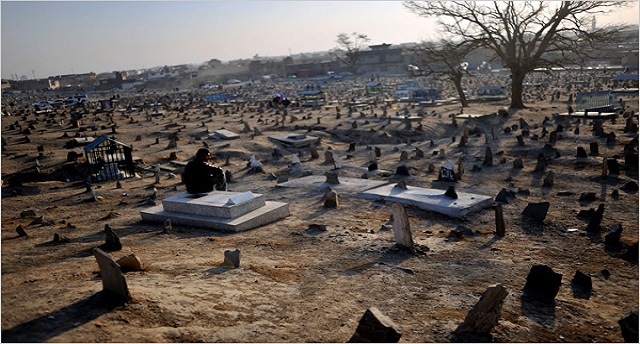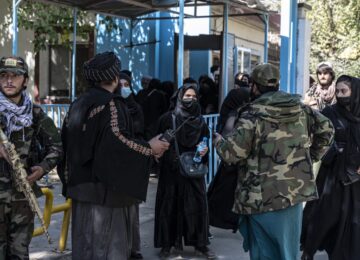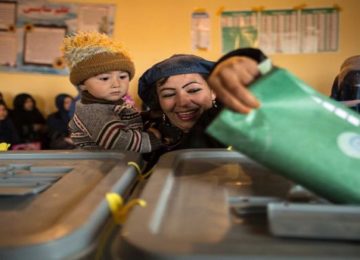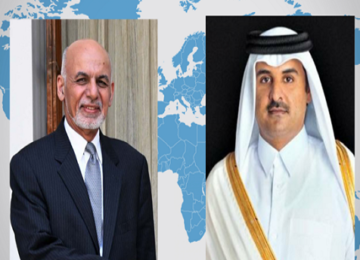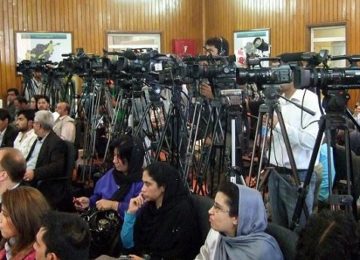There has been a six per cent decrease in the number of civilians killed and wounded in the conflict this year compared to the first nine months of 2016 – a year which saw record highs in civilian harm. The latest UNAMA report on civilian casualties provides, as always, sobering statistics of how Afghan civilians are being killed and injured in the war and by whom. AAN’s Kate Clark has been looking at the figures and assessing what they say about trends in the conflict. She also takes a special look at what the recently announced, intensified air campaign by the United States and Afghan air forces may mean for Afghan civilian casualties.
This latest report from UNAMA covers the first three quarters of this year (1 January to 30 September 2017), comparing them with the same period in 2016. It can be read here.)
There is some good news in UNAMA’s latest report, primarily that civilian casualties have fallen compared to the first nine months of last year. However, it was a slight decrease and masked a one per cent increase in civilian deaths. It was also only a reduction from a record high for civilian casualties in 2016. Such fluctuations in quarterly reporting have been seen before without annual reductions. (The last annual fall was in 2012 compared with 2011 – see AAN analysis here.) Even so, the reduction of six per cent in civilian deaths and injuries is welcome. In total, UNAMA documented 8,019 civilian casualties in the first nine months of the year (2,640 people killed and 5,379 injured).
What UNAMA defines as anti-government elements, ie insurgent groups, (1) were responsible for the bulk of the casualties: 5,167 overall (1,760 deaths and 3,407 injured) or 68 per cent of the total during the first nine months of 2017. They caused one per cent fewer civilian casualties compared to the same period last year. UNAMA attributed 66 per cent to the Taleban, 10 per cent to Islamic State Khorasan Province (ISKP), aka Daesh, and the remainder to “unidentified Anti-Government Elements, including self-proclaimed Daesh/ISKP.” The figure for ISKP is huge, considering their limited territorial footprint, but is a consequence of their willingness to attack unprotected gatherings of civilians for sectarian reasons. (See recent AAN analysis here.)
Civilian casualties attributed to pro-government forces – UNAMA’s term for Afghan government and international forces (primarily the United States, which is now the only country with a combat mission in Afghanistan) and militias under their control (2) – were 19 per cent lower, compared to the first nine months of 2016. Pro-government forces were responsible for 1,578 civilian casualties (560 deaths and 1,018 injured), or 20 per cent of the total. Over half of these occurred during ground fighting.
UNAMA said it could not attribute eleven per cent of civilian casualties to either side, but said they occurred during fighting. (3)
Causes of civilian deaths and injuries
The fall in civilian casualties so far this year was particularly marked in ground engagements, which is still the largest overall cause of civilian harm. Deaths and injuries here fell by 15 per cent overall and by 37 per cent in those attributed to pro-government forces. UNAMA reported a seven per cent rise in casualties from anti-government elements in ground engagements. Ground engagements caused 35 per cent of civilian casualties in the first nine months this year – 2,807 overall (684 deaths and 2,123 injuries)
UNAMA said the government’s commitment to mitigating civilian casualties had “led to fewer civilian deaths and injuries from their operations.” This was particularly marked in the north-east. (4) This was a change in tone from UNAMA’s 2016 annual report when it called for a cessation in the use of indirect use of mortars, rockets, grenades and other weapons in civilian-populated areas. “[C]lear tactical directives, rules of engagement and other procedures,” it said, needed to be developed for the use of explosive weapons.
The other factor, however, reducing the casualties in ground engagements was that there were less of them this year. Frontlines have been relatively static in the south, (5) unlike last year which saw heavy fighting in both Helmand and Uruzgan provinces, including two attempts by the Taleban to capture Lashkargar in Helmand and insurgent offensives against Tirin Kot in Uruzgan, as well as attacks on many of the districts of those two provinces. In the north, the Taleban also overran most parts of Kunduz city, before being driven back. This year, so far, there have been no major Taleban offensives against any large population centres.
One factor, not mentioned by UNAMA, may be the increased threat to the Taleban from the air, with both the Afghan Air Force (AAF) and US Air Force increasing the numbers of sorties flown and munitions dropped (more on this below). This may be reversing a trend seen from 2014 onwards, when ground engagements became the main cause of civilian casualties (the trend was visible from 2013. This had come about, as international aircraft were withdrawn and the Taleban were able to mass in large numbers and launch ground offensives without fear of being wiped out from the air. Significantly, the increase in the casualties from the Taleban side this year were largely from “small arms fire”, not heavy weapons.
Both the US and Afghan air forces have become more active in 2016 and that is reflected in the civilian casualties resulting from aerial strikes. Although still representing only six per cent of the total number of civilian casualties reported, the increase in the actual numbers was sharp: 52 per cent more civilians were killed and injured from the air in the first nine months of 2017, compared with the same period in 2016, with two thirds of the casualties women and children. 466 civilians were killed and injured in aerial operations in the first nine months of the year (205 deaths and 261 injuries). UNAMA attributed 38 per cent of those casualties to the international military (the remainder would be either from the Afghan Air Force or made up of incidents which could not be attributed to either.) The issue of airstrikes will be analysed in more detail below.
Other trends made evident in UNAMA reporting were a four per cent decrease in casualties from suicide and complex attacks, although that included 13 per cent more deaths. Such attacks result in 20 per cent of total civilian casualties – 1,584 in all (382 deaths and 1,202 injuries).
There was also a reduction in the number of civilian casualties from IEDs. They were responsible for 18 per cent all civilian casualties in the first nine months of the year, a reduction of eight per cent compared to the same period in 2016. There were 1,403 casualties (498 deaths and 905 injuries) from IEDs. The use of indiscriminate and therefore unlawful pressure-plate IEDs on roads used by civilians led to 803 civilian casualties (371 deaths and 432 injured), reflecting an 11 per cent increase in deaths from these devices. A quarter of these fatalities were children.
Many more civilians have been killed and injured in targeted and deliberate killings this year: there was a 13 per cent overall increase in casualties and a 33 per cent spike in civilian deaths. UNAMA said it had documented “disturbing trends of intentional killings targeting religious leaders, civilians perceived to support the Government or Afghan national security forces, and continued attacks against civilian Government workers and judicial and prosecutorial figures.”
Another troubling statistic was the many Shia Muslim Afghans killed and injured in the first nine months of the year. There were 278 civilian casualties (84 deaths and 194 wounded) of worshipers targeted as they attended mosques or religious ceremonies. (See recent AAN reporting here.
Air strikes and Civilian Casualties
Only six per cent of all civilian casualties in the conflict up to 30 September 2017 were a result of air strikes. While bearing this in mind and also the tendency for air strikes, particularly those conducted by the US Air Force, to receive a disproportionate attention in the Afghan and international media, it seemed reasonable to look at this issue in more detail, given the 52 per cent rise in casualties caused by them in the first nine months of the year (a trend continuing from 2016). It is especially relevant given the plans to intensify the US and Afghan air campaign further and, on the US side, the loosening of restrictions on when air strikes can be ordered.
Last year, in its 2016 annual report on the protection of civilians, UNAMA called for “an immediate halt to the use of airstrikes in civilian-populated areas and… greater restraint in the use of airstrikes where civilians are likely to be present.” It also wanted “[C]lear tactical directives, rules of engagement and other procedures” developed and implemented for the use of armed aircraft. In this report, it “reiterated its concern at continued increases in civilian casualties from aerial attacks, particularly among women and children.”
On 10 October 2017, the US and NATO commander in Afghanistan General Nicholson warned the Taleban that “a tidal wave of air power is on the horizon.” Both the US and Afghan air forces are flying more sorties, dropping more munitions and planning further increases in operations. The US Special Inspector General for Afghanistan Reconstruction (SIGAR) reported a 24 per cent increase in personnel in the Afghan Air Force in the second quarter of 2017, compared to the first quarter and an 83 per cent increase in sorties flown over the same three months. Some of that was due to “a slightly lower tempo of operations in the winter months,” it said, but it was largely due to “a considerable increase in the AAF’s recent operational activity.” It did not report on the number of munitions dropped.
Meanwhile, the US Air Force has also been more active, dropping munitions in quantities not seen since ‘the surge’ – the period 2009 to 2012 when 100,000 US troops came to be deployed to fight the Taleban (NB the first available data on US air munitions and sorties is from 2012). The US Airforce has reported that September 2017 “marked a record high month for weapons employed in Afghanistan since 2012, with 751 munitions being delivered against Taliban and ISIS–Khorasan targets; a 50 percent jump from August.” The nearest known comparable months are July and August 2012, with, respectively, 504 and 509 munitions dropped. The comparable yearly figures are 947 munitions delivered by the US Air Force in Afghanistan in 2015, 1,337 in 2016 and, already in the first nine months of this year, 3,238. (Data here)
In testimony to the US Congress on 4 October 2017, Secretary of State for Defence Jim Mattis described how President Trump had made it easier to launch air strikes. (His comments were widely reported, although the transcript of the hearing has yet to be published):
“At one time, sir, we could not help Afghan forces unless they were in extremis” — that is, under direct, urgent threat, Mattis said. “And then eventually that was rescinded, but they still had to be in proximity. They had to be in contact [ie coming under fire from insurgents]. Today, wherever we find them, the terrorists — anyone trying to throw the NATO plan off, trying to attack the Afghan people and the Afghan government — then we can go after them.”
President Obama had already loosened restrictions imposed under the 2014 Bilateral Security Agreement (BSA) which had only allowed combat operations against al Qaeda and “its associates”. From June 2016, strikes could also be ordered against the Taleban and for “strategic effects” (for example to prevent a population centre falling to the Taleban) and not just “counter-terrorism” (for more detail, see earlier AAN analysis on the US military strategy. The Chairman of the Joint Chiefs of Staff, General Joseph Dunford, who also testified to Congress, gave further details or the changes.
“The conditions aren’t specific to, as Sec. Mattis alluded to, a specific engagement or a specific time,” Dunford added. “So if they’re in an assembly area, a training camp, and we know they’re an enemy and a threat to the Afghan government, our mission or our people, [US and NATO commander in Afghanistan] Gen. Nicholson has the wherewithal and flexibility to make that decision.”
Significantly, the extra 3500 or so US forces, announced on 3 October 2017 as being deployed to Afghanistan are operating at a much lower level. They are operating in battalions, rather than just advising at corps headquarters. Mattis referred to them as combat troops: “The fighting will continue to be carried out by our Afghan partners,” he said, “but our advisers will accompany tactical units to advise and bring NATO fire support to bear when needed… Make no mistake, this is combat duty.” It seems the post-2014 fudge when President Obama wanted to carry on fighting in Afghanistan and insist that the combat mission was over, when it was not clear which US forces were involved in ‘the can be combat’ US Freedom Sentinel’s mission and the non-combat NATO Resolute Support mission is at an end. US forces will now be openly deployed in the field, calling in airstrikes and providing direct tactical advice on the front lines to Afghan forces.
The Afghan Air Force is doing better than it has before – although the historical precedents are very poor. War crimes reporting from before 2002 shows the sustained use of the Afghan Air Force to target civilians, when it was controlled by the PDPA (a junior partner to the Soviet air force which carried out widespread bombing of rural areas in the 1980s) and later by Shura-e Nazar and Jombesh, who got hold of the remnants of the air force after the fall of the PDPA regime in 1992 and used them to bomb civilian areas during the civil war in Kabul (all factions also used artillery indiscriminately in the capital). The Taleban, who seized some of those even fewer remaining air assets also used them to bomb civilians, including the hospital and Oxfam office in Yakowlang, in Bamyan province in 2001, and opposition-held parts of Dara-ye Suf district, in Samangan province in 2000, even bombing people who fled the town and tried to seek shelter in the mountains.
The current Afghan Air Force may not be targeting civilians as its previous incarnations did, but it has to do much more to avoid civilian casualties. UNAMA notes that, in October 2017, the Government formally endorsed the National Policy on Civilian Casualty Prevention and Mitigation, which covers all of the ANSF, not just the air force. The UN Secretary General’s Special Representative in Afghanistan, Tadamichi Yamamoto, said there must be a full implementation of the new policy and in particular: “…ensure the impartial examination and systematic tracking of civilian casualties and is legally obliged to ensure independent investigations into any incidents causing civilian casualties that may amount to serious violations of international humanitarian law.”
It is especially necessary to watch how the Afghan Air Force develops, given that its role is planned to expand markedly in the next five years. This expansion is a key component of the current US/Afghan military strategy (see here and here) and training, hardware and considerable US funding is in the pipeline. (7)
Assessing the plans to intensify the air campaign
That many more Afghan civilians have been killed and injured in air strikes so far this year compared to 2016 is clear. From the data available, though, it is impossible to determine whether, proportionate to the number of strikes, more civilians are being killed and injured (which would indicate poorer efforts to protect civilian casualties) or not. In calculating the overall calculus of civilian harm from air strikes, the decrease in casualties from ground engagements, which may partly be a result of the increased air deterrent on the Taleban, would also need to be factored in. Nevertheless, there are elements of the US and Afghan strategy to increase the use of air strikes which already ring alarm bells.
First, compared to the pre-2014 period, the US military command is far less transparent: in those earlier years, there was a real engagement with national and international organisations (including the UN and concerned NGOs, such as AAN) on how to mitigate civilian casualties. There was also a genuine effort, in training, tactical directives, (6) command and control, reporting and investigating, to minimise the harm to civilians. The US motivation was the realisation of the damage that dead and injured Afghan civilians were doing to its war effort. That emphasis on protecting civilians is no longer evident.
Pre-2014, there was also much more political pressure to avoid civilian casualties: an angry President Karzai and frequently outraged Afghan media has been replaced by the rather silent President Ghani and Chief Executive Abdullah and a far more subdued media. The current government recognises its dependence on the US and has been far less likely to criticise. If civilian casualties really rise, however, popular discontent may force this onto the political agenda again.
The second question, however, is what is the overall aim of this policy? General Nicholson, delivering Black Hawk helicopters to the Afghan Air Force at what The Washington Post described as an “elaborately staged ceremony at Kandahar Air Base [which] marked the formal launch of an ambitious plan to modernize and expand the Afghan air force over the next five years” (see here), vowed that the escalation of the air campaign would be “the beginning of the end for the Taliban.” His words brought a strong sense of déjà vu, not only claims made during the surge years, but even earlier, to 2001, claims that in the end amounted to nothing.
If the intensified air campaign is just aimed at pushing the Taleban back, although we may see that happen, we would also likely see the insurgents adapting their strategy. They did this before, after suffering huge losses in ground engagements in 2006 and 2007. They also bounced back very rapidly after US surge troops left and then most international forces withdrew in 2014; Afghan forces proved unable to hold the territory that the foreign troops had won. The Afghan insurgency tends to adapt, which means that new strategies and the creation or expansion of forces have not, in the long run, lead to territory being held, civilians protected or there being any decisive reduction in the level of violence: the war continues, in different ways. The US and Afghan strategy only makes sense – unless a forever war is really the preferred option – if any gains against the Taleban are exploited politically and the same energy and commitment is put into finding a political, negotiated end to the war, as has been shown in fighting it.
(1) In UNAMA’s 2016 Protection of Civilians, it wrote:
Anti-Government Elements encompass all individuals and armed groups involved in armed conflict with or armed opposition against the Government of Afghanistan and/or international military forces. They include those who identify as ‘Taliban’ as well as individuals and non-State organized armed groups taking a direct part in hostilities and assuming a variety of labels including the Haqqani Network, Islamic Movement of Uzbekistan, Islamic Jihad Union, Lashkari Tayyiba, Jaysh Muhammed, groups that identify as “Daesh”/Islamic State Khorasan Province and other militia and armed groups pursuing political, ideological or economic objectives including armed criminal groups directly engaged in hostile acts on behalf of a party to the conflict.
(2) UNAMA in its 2016 Protection of Civilians report wrote:
The term “Pro-Government Forces” includes the Afghan Government’s national security forces and other forces and groups that act in military or paramilitary counter-insurgency operations and are directly or indirectly under the control of the Government of Afghanistan. These forces include, but are not limited to, the Afghan National Army (ANA), Afghan National Police (ANP), Afghan National Border Police, National Directorate of Security and Afghan Local Police – which operate under Government legal structures – and pro-Government armed groups and militias that have no basis in Afghan law and do not operate under formal Government structures. This term also includes international military forces and other foreign intelligence and security forces.
(3) Some will have resulted from ‘explosive remnants of war’ left over from fighting. They killed 134 civilians and injured 378, most of them children. The Afghan government has now formally ratified Protocol V to the 1980 Convention on Certain Conventional Weapons concerning explosive remnants of war. “The implementation of this protocol,” said Danielle Bell, Chief of UNAMA’s Human Rights Service, “which will come into effect in February 2018, will prevent many similar and avoidable casualties from occurring in the future”
(4) UNAMA includes in the northeastern region, Badakhshan, Baghlan, Takhar, and Kunduz provinces.
(5) UNAMA defines the southern region as comprising Helmand, Kandahar, Nimruz, Uruzgan, and Zabul.
(6) In 2012, the then commander of US and NATO forces, General John Allen issued a new ‘fragmentary order’ altering the tactical directives outlining offensive fires could be delivered. Civilian residences could no longer be targeted unless, as Allen said, “my troops are pinned down, can’t move, and the only option they have is to deliver fires on these structures, or I decide, the senior leader out here, I decide to deliver fires on these structures.” The result, he of the new order, he said, was that civilian causalities as a result of air fires, “plummeted immediately.” Before then, air fire had been the main way in which civilians were killed by ‘pro-government forces’ (international military and ANSF together), killing four times as many civilians as any other tactic.
(7) SIGAR’s most recent report, to the end of June 2017, reported that:
As of May 18, 2017, the United States has appropriated approximately: $5.2 billion to support and develop the AAF since FY [financial year] 2010, with roughly $1.5 billion of it requested in FY 2017. Of the total amount since 2010, $2.2 billion was spent on the Special Mission Wing, the special operations branch of the AAF. CSTC-A [Combined Security Transition Command – Afghanistan] noted that the FY 2017 figure includes DOD’s recent request to Congress for $814.5 million to fund the Afghan Aviation Transition Plan (AATP), which will replace the AAF’s aging, Russian-made Mi-17 fleet with refurbished, U.S.-made UH-60 Black Hawk helicopters obtained from U.S. Army stocks.
It added:
The AAF’s current inventory of aircraft includes:
4 Mi-35 helicopters
46 Mi-17 helicopters (19 unusable)
27 MD-530 helicopters (one unusable, two combat losses)
24 C-208 utility airplanes
4 C-130 transport airplanes (one unusable)
19 A-29 light attack airplanes (12 are currently in Afghanistan and seven are in the United States supporting AAF pilot training)
SIGAR also said that:
As part of the AATP, over the next several years, the AAF will receive a significant number of new or refurbished airframes to grow the AAF’s inventory. According to USFOR-A, in FY 2017, two more A-29 aircraft have been purchased, but not yet fielded. In order to replace the AAF’s aging Mi-17s, the United States has also procured 53 UH-60 Black Hawk helicopters as well as 30 MD-530s, three AC-208s, and four additional A-29 aircraft (for a total of six) using FY 2017 funds.289 While the delivery timelines and training requirements are still being determined, by the end of the AATP in 2023, the AAF will have a total of 61 UH-60s, 58 Fixed Forward Firing UH-60, 54 MD-530s, 24 C-208s, 32 AC-208s, 4 C-130 aircraft, and 25 A-29s.
By Special Arrangement with AAN. Original link.
Disclaimer: Views expressed in the article are not necessarily supported by Afghan Studies Center.



